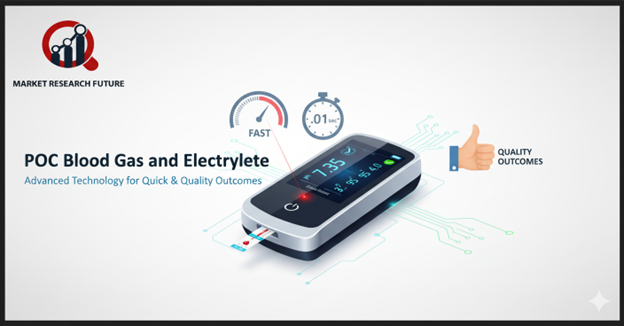
Point-of-Care (POC) Blood Gas and Electrolyte Market Overview
The Point-of-Care (POC) Blood Gas and Electrolyte Devices Market is witnessing robust growth, fuelled by the increasing prevalence of chronic diseases such as diabetes, obesity, chronic kidney disease, and liver disorders, coupled with a rising need for rapid diagnostics and efficient patient management. These devices play a crucial role in critical care settings, enabling immediate assessment of key parameters including PCO₂, TCO₂, HCO₃, pH, SO₂, and electrolytes, thereby reducing overall treatment time and improving clinical outcomes.
As healthcare systems shift toward decentralized testing and patient-centric care, POC technologies are emerging as indispensable tools for faster diagnosis, improved workflow efficiency, and enhanced patient satisfaction.
Market Growth Influencers
1. Rising Burden of Chronic Diseases
The escalating incidence of diabetes, kidney disorders, and cardiovascular conditions has amplified the demand for POC testing solutions that provide real-time diagnostic insights. These devices enable clinicians to make swift, informed decisions, particularly in emergency and intensive care units, where time-sensitive interventions are critical.
2. Technological Advancements Driving Accuracy and Efficiency
Manufacturers are investing heavily in innovative technologies that improve device accuracy, portability, and user-friendliness. POC systems eliminate multiple steps involved in conventional laboratory testing—such as sample collection, transportation, and reporting—thereby streamlining workflows. However, continuous R&D efforts are focused on minimizing potential inaccuracies and enhancing data integration with hospital information systems (HIS).
3. Strategic Collaborations and Industry Consolidation
Leading players are pursuing strategic partnerships, acquisitions, and product portfolio expansions to strengthen market presence.
- Siemens Healthineers’ acquisition of Epocal Inc. added the epoc® Host2 system to its offerings.
- F. Hoffmann-La Roche Ltd. expanded capabilities through the acquisition of TeraMedica, Inc.
Such collaborations foster innovation and accelerate the introduction of next-generation POC solutions.
4. Growing Demand for Portable and Home-Based Testing
The demand for portable POC devices is surging due to their ease of use, mobility, and applicability across hospitals, clinics, and home-care settings. These devices support timely decision-making and better patient outcomes, particularly in regions with limited access to centralized laboratories.
5. Challenges: Accuracy and Cost Constraints
Despite the benefits, concerns persist regarding testing precision compared to traditional lab systems. Additionally, high device and test costs and data integration challenges may restrict adoption in resource-limited settings. Manufacturers are actively addressing these limitations through technological innovation and cost-optimization strategies.
Market Segmentation
By Product Type
- Instruments
- Consumables
By End User
- Hospitals & Clinics
- Diagnostic Laboratories
- Home Care Settings
By Application
- Critical Care
- Neonatal Care
- Emergency Medicine
By Region
- North America
- Europe
- Asia-Pacific
- Middle East & Africa
- Latin America
Regional Insights
- North America leads the global market, driven by advanced healthcare infrastructure, high adoption of point-of-care testing, and strong presence of key players such as Abbott, Siemens Healthineers, and Roche.
- Europe follows with steady growth, supported by rising prevalence of chronic diseases, government-funded healthcare programs, and adoption of innovative diagnostics across Germany, the U.K., and France.
- Asia-Pacific is poised for the fastest growth, propelled by increasing healthcare awareness, government initiatives, and growing patient population in China, India, and Southeast Asia.
- Latin America, the Middle East, and Africa are emerging markets, benefiting from improving healthcare access, rising investments, and expanding diagnostic capabilities.
Key Market Players
Prominent companies shaping the POC blood gas and electrolyte devices market include:
- Siemens Healthineers AG
- Abbott Laboratories
- F. Hoffmann-La Roche Ltd.
- Radiometer Medical ApS
- Instrumentation Laboratory
These players are actively engaged in product development, strategic acquisitions, and R&D investment to deliver advanced, reliable, and accessible diagnostic solutions.
Future Outlook
The POC blood gas and electrolyte devices market is set for sustained expansion as healthcare providers embrace rapid, decentralized testing. The future will be shaped by:
- Technological integration with hospital information systems
- Enhanced accuracy and automation
- Growing adoption in emerging economies
- Personalized and patient-centric diagnostic approaches
While accuracy and cost barriers remain, the shift toward portable, real-time, and efficient diagnostics will continue to drive market momentum.
Conclusion
As healthcare systems worldwide prioritize speed, precision, and patient outcomes, POC blood gas and electrolyte devices are becoming essential in modern clinical practice. Backed by technological innovation, strategic collaborations, and rising chronic disease prevalence, the market is on a strong growth trajectory. The coming years will witness deeper penetration in developing regions, broader use in critical care, and continuous improvement in device performance.